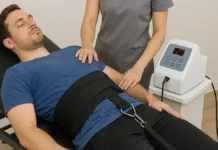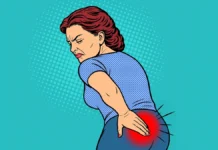Lumbopelvic rhythm is the synchronization of movements between the pelvis and trunk during the movement of bending forward and returning to standing.
Introduction
According to Cailliet, the first part of forward flexion consists of lumbosacral flexion followed by an anterior tilt of the pelvis at the hip joints.
Lumbopelvic rhythm constitutes a fundamental component of human biomechanics, influencing the coordination of movements between the lumbar region and the pelvis. This delicate timing is particularly highlighted during the forward bending movement and return to standing, actions as simple as bending over to pick up an object from the ground. Although the term “lumbopelvic rhythm” is not formally defined in the standard medical lexicon, it finds its place in the field of physiotherapy and biomechanics to describe this essential interaction.
This in-depth exploration looks at the anatomical mechanisms, such as lumbosacral flexion and anterior pelvic tilt, involved in this rhythm. From the lordotic lumbar curve to precise muscle coordination, each element helps ensure stability, mobility and the prevention of muscle tension. Understanding these aspects is of crucial importance for maintaining healthy body mechanics, preventing injuries and promoting optimal quality of life. With this in mind, let’s dive into the complex mechanisms of lumbopelvic rhythm and its impact on our daily activities.
Definition of Lumbo-Pelvic Rhythm
The term “Lumbo-Pelvic Rhythm” refers to the coordination of movements between the lumbar region (lower spine) and the pelvis during certain movements, particularly the forward bending movement and return to standing. . This coordination is crucial to ensure effective body mechanics and prevent strain or injury in the lumbar and pelvic region.
When we bend forward and return to a standing position, Lumbo-Pelvic Rhythm describes how the lumbar spine and pelvis work together to enable these movements. Here is an explanation of the synchronization of movements during these actions:
- Forward bending:
- During forward flexion, the pelvis tilts forward into an anterior tilt.
- The lumbar spine follows this inclination by bending forward.
- The abdominal muscles, hip flexors and lumbar muscles are used to allow this coordinated movement.
- Return to standing position:
- When returning to a standing position, the pelvis tilts backwards into a posterior tilt.
- The lumbar spine follows this inclination by straightening.
- The back extensor muscles, gluteal muscles, and spinal stabilizer muscles are activated to support the upward movement.
Precise coordination between the pelvis and lumbar spine is essential to avoid excessive strain on the lumbar region, prevent injuries, and maintain proper posture. An imbalance in Lumbo-Pelvic Rhythm can lead to poor body mechanics, excessive pressure on the intervertebral discs, and potentially contribute to problems such as back pain or muscle tension.
It is important to note that the mobility and stability of the lumbar spine, pelvis and surrounding joints play a crucial role in the success of this rhythm. Strengthening, stretching and stabilization exercises may be recommended to improve Lumbo-Pelvic Rhythm and promote smooth, balanced movements when bending forward and returning to a standing position.

Anatomical Mechanisms
The concepts of lumbosacral flexion and anterior pelvic tilt involve the anatomical mechanisms of the lumbar region and hip joints. Dr. Cailliet, in his work “Soft Tissue Pain and Disability,” contributed to explaining these anatomical mechanisms. Here are details on these concepts:
- Lumbo-Sacral Flexion:
- Anatomical level: Lumbosacral flexion occurs at the junction between the lumbar spine (lower spine) and the sacrum (lower part of the spine).
- Joints involved : The lumbar intervertebral joints and the lumbosacral junction play a major role in lumbosacral flexion. These joints allow flexion and extension movements in the lumbar region.
- Related Movements: Lumbosacral flexion is often associated with anterior pelvic tilt, a movement that involves the hip joints. These two movements are usually synchronized during movements such as forward bending.
- Anterior tilt of the pelvis:
- Anatomical level: The anterior tilt of the pelvis occurs at the coxofemoral joint, the hip joint.
- Joints involved: The coxofemoral joint, where the head of the femur articulates with the acetabulum of the pelvis, is the main joint involved in the anterior tilt of the pelvis.
- Associated movements: The anterior tilt of the pelvis is often coupled with lumbosacral flexion. When the pelvis tilts forward, this contributes to the anterior tilt of the lumbar spine.
- Muscles involved: Hip flexor muscles, such as the iliopsoas, are activated during anterior tilt of the pelvis. These muscles play an essential role in hip flexion and forward tilt of the pelvis.
- Stabilization: The stabilizing muscles of the spine, including the abdominal muscles, are also used to stabilize the lumbar region during these movements.
| Initial movement | Latent movement | |
| Trunk flexion | Flexion of the lumbar, loss of lordosis, the lower part becomes flat | Anterior tilt of the pelvis |
| Trunk extension | Posterior pelvic tilt | Lumbar extension |
Nature of the Term “Lumbo-Pelvic Rhythm”
The term “Lumbo-Pelvic Rhythm” is not a standardized medical or anatomical term widely recognized in the scientific literature. However, it is often used in the context of osteopathy, biomechanics and other fields related to health and physical performance to describe the coordination of movements between the lumbar region (lower spine) and the basin.
The underlying idea behind the term is to express the rhythmic synchronization of movements between the lumbar spine and pelvis during certain activities, such as bending forward and returning to a standing position. Although the term may not be formally recognized in anatomical nomenclature, it provides a convenient way to conceptualize how these two regions of the body interact in movement.
Coordination between the lumbar region and the pelvis is crucial to ensure proper biomechanics, prevent injury, and maintain normal trunk function. Movements such as forward bending, trunk rotation, and other activities require a harmonious interaction between these two anatomical regions.
It is important to note that, although the term is not standardized, the idea it expresses is supported by well-established anatomical and biomechanical principles. For example, the coordination of movements between the lumbar spine and the pelvis is closely related to the mechanisms of the lumbosacral joint and the hip joint, as discussed previously.
In conclusion, although the term “Lumbo-Pelvic Rhythm” is not formally defined in the standard medical lexicon, its use fits into a practical context to describe the coordination of movements between the lumbar region and the pelvis. This coordination is essential for maintaining healthy body mechanics and can be a useful concept in the areas of rehabilitation, injury prevention, and improvement of physical performance. When using non-standardized terms, it is always important to clearly define them to avoid confusion in communication.
Importance of Lumbo-Pelvic Movement
Coordination between the lumbar spine and pelvis, often referred to as lumbopelvic movement, is critically important for performing many daily activities. This harmonious coordination plays a central role in trunk mobility, stability and balance, thereby affecting the quality of movements such as walking, running and other activities involving the trunk. Here are some points highlighting the importance of this coordination:
- Walking and Running:
- Stability and Balance: When walking and running, lumbopelvic movement contributes to core stability and balance. Coordination between the lumbar spine and pelvis helps maintain proper posture during movement.
- Force Transmission: Effective lumbopelvic movement allows the effective transmission of force generated by the lower limbs to the upper body, thus facilitating a fluid and energetic gait.
- Daily Life Activities:
- Flexibility and Adaptability: Lumbopelvic movements are essential for trunk flexibility and adaptability during daily activities such as bending, sitting, standing, and reaching objects at different heights.
- Reduction of Stress: Proper coordination between the lumbar spine and pelvis contributes to the reduction of stress on the spine while performing various tasks, thereby minimizing the risk of muscle tension and back pain.
- Sporting activities :
- Athletic Performance: In sporting activities such as golf, tennis, or other sport-specific trunk movements, precise coordination of lumbopelvic movement is essential to optimize performance and prevent injury.
- Trunk Rotation: The ability to coordinate rotation between the lumbar spine and pelvis is particularly crucial in many sports and physical activities that involve rotational movements of the trunk.
- General Posture and Well-Being:
- Posture Maintenance: Coordination of lumbopelvic movement helps maintain proper posture, which is essential for spinal health and prevention of postural problems.
- General Well-Being: Effective coordination of lumbo-pelvic movement is associated with general well-being, reducing discomfort, tension and contributing to a better quality of life.
Lumbar Curve
Lumbar curve, also called lumbar lordosis, refers to the natural curvature of the spine in the lumbar region, that is, the lower part of the spine. Lumbar lordosis is characterized by a concave forward curvature, and it is considered a normal curvature of the spine. This curvature plays an important role in the distribution of forces and the ability to absorb shock during various movements.
When you look at the spine in profile, lumbar lordosis creates a forward curvature, which is more pronounced in the lumbar region than in other parts of the spine. This natural curvature is formed by the lumbar vertebrae (L1 to L5) and contributes to the stability and mobility of the spine.
When flexing the lumbar spine, several changes occur, and the lumbar vertebrae may temporarily flatten. Here’s how it works:
- Flexion of the Lumbar Spine:
- When you lean forward or flex your lumbar spine, the intervertebral discs located between the lumbar vertebrae experience compression.
- This compression results in a reduction in the intervertebral space and can cause a slight flattening of the articular surfaces of the vertebrae.
- Temporary Flattening:
- During flexion, the intervertebral discs, which act as shock-absorbing cushions between the vertebrae, experience increased pressure.
- The temporary flattening of the articular surfaces of the vertebrae is a response to this pressure, allowing the spine to adapt to changes in load during movement.
- Return to Initial Position:
- When you return to an upright position, the lumbar lordosis returns to its normal curvature.
- The intervertebral discs rehydrate and recover their normal height, and the concave forward lumbar curvature is restored.
It is important to note that temporary flattening of joint surfaces during flexion is a normal response of the musculoskeletal system to allow functional mobility while maintaining spinal stability. However, excessive movement, poor posture, or structural issues can cause additional stress on the lumbar spine, increasing the risk of injury or lower back pain.
It is recommended to maintain good posture and adopt proper lifting techniques to prevent excessive strain on the lumbar spine. If you experience persistent lower back pain or mobility issues, it is advisable to consult a healthcare professional, such as a physiotherapist or orthopedist, for a thorough assessment and tailored advice.
Muscle Movements and Contractions
Forward bending is a movement that uses multiple muscle groups, primarily involving the spine and hip joints. During this movement, muscle contraction is essential to control the movement, provide the necessary force and stabilize the spine. Here is a description of the muscular mechanisms involved during forward bending:
- Eccentric Contraction of the Extensor Muscles of the Lower Back:
- Main Muscles Involved: The extensor muscles of the lower back, such as the erector spinae muscles, are heavily used during forward bending.
- Mechanism: When bending forward, the extensor muscles of the lower back undergo eccentric contraction. This means they contract while stretching, acting as brakes to slow movement and control spinal flexion.
- Role: Eccentric contraction of the extensor muscles of the lower back helps maintain a certain stability of the spine and prevents too rapid or excessive flexion.
- Concentric Contraction of the Hip Flexor Muscles:
- Main Muscles Involved: The hip flexor muscles, such as the iliopsoas and rectus femoris, are activated during forward flexion.
- Mechanism: These muscles undergo concentric contraction, meaning they shorten as they contract to produce the hip flexion movement.
- Role: Concentric contraction of the hip flexor muscles pulls the trunk forward helping to bend the hips and bring the torso closer to the thighs during forward flexion.
- Role of the Abdominal Muscles:
- Activation of Abdominal Muscles: The abdominal muscles, particularly the anterior wall muscles such as the rectus abdominis and obliques, play a vital role in forward bending.
- Trunk Stabilization: The abdominal muscles contract to stabilize the trunk during the flexion movement, helping to protect the spine.
It is important to note that the precise coordination of these muscle contractions is crucial to ensure smooth and controlled movement during forward bending. An imbalance or weakness in any of these muscle groups can increase the risk of muscle strains, lower back pain, or other problems.
When performing the forward bend, it is recommended to maintain good posture, pay attention to lifting technique, and include muscle strengthening and stretching exercises to maintain muscle balance and prevent imbalances. If problems persist, it is advisable to consult a healthcare professional, such as a physical therapist, for further evaluation.
Initial and Latent Movements
The terms “initial movements” and “latent movements” are often used to describe changes observed in posture and trunk movements during certain activities, including trunk flexion and extension. These terms are often used in the context of postural assessment, movement analysis and physical rehabilitation. Let’s explore these concepts by highlighting trunk flexion and extension, loss of lordosis, and changes in pelvic position:
- Initial Movements:
- Trunk Flexion: The initial movements of trunk flexion occur when the trunk tilts forward from the neutral standing position. This can be observed during activities such as bending to pick up an object from the ground.
- Loss of Lordosis: During initial flexion, lumbar lordosis (concave forward curvature in the lumbar region) may decrease or be lost temporarily as the spine tilts forward.
- Latent Movements:
- Trunk Extension: Latent movements of trunk extension occur when there is counterflexion or straightening of the trunk from a flexed position. This can be observed when returning to a standing position after bending forward.
- Return to Lordosis: During latent extension movements, lumbar lordosis is gradually restored as the spine straightens.
- Changes in Pelvic Position:
- Anteversion and Retroversion: During trunk flexion, the pelvis undergoes changes in its position. Pelvic anteversion (pelvis tilted forward) often accompanies flexion, while pelvic retroversion (pelvis tilted backward) may accompany extension.
- Pelvic Rotation: Trunk flexion and extension are also associated with pelvic rotations, which influence the relative position of the pelvis. For example, during flexion, the pelvis may undergo posterior rotation.
These initial and latent movements, as well as changes in pelvic position, are essential for daily activities such as bending, picking up objects, and standing up. Proper coordination between the spine and pelvis is necessary to avoid excessive stress on the lumbar spine and prevent unwanted muscle strain.
In a context of rehabilitation or postural correction, it is often relevant to work on mobility, stability and muscular control to optimize these movements, minimize imbalances and promote healthy body mechanics. An osteopath can develop specific exercises to improve these aspects of movement based on individual needs.
Conclusion
In conclusion, lumbopelvic rhythm, although not a medically standardized term, is of significant importance in the coordination of movements between the lumbar region and the pelvis. Understanding the anatomical mechanisms, such as lumbosacral flexion and anterior pelvic tilt, is crucial to appreciate its impact on daily activities such as walking and running.
The lumbar curve, with its lordosis shape, plays an essential role in these movements, requiring precise coordination of the muscles involved. Muscle contractions, including eccentric contraction of the lower back and hip extensor muscles, as well as concentric contraction of the hip flexor muscles, help maintain balance during forward bending.
However, potential problems can arise, particularly with weakened or tired muscles, which can lead to strain and risk of muscle tearing. Returning to upright posture requires reverse coordination, emphasizing the importance of precise control of lumbopelvic rhythm.
In summary, lumbopelvic rhythm is a key aspect of human biomechanics, influencing trunk stability and mobility. Understanding these mechanisms offers crucial insights for preventing muscle strain and promoting healthy lumbar function, highlighting the importance of maintaining adequate balance between the lumbar spine and pelvis in our daily activities.

























